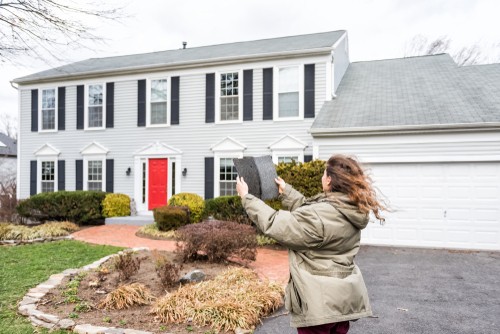The Mid-Atlantic may not be in the hurricane target zone but that doesn’t mean strong storms, pounding rain and driving wind can’t do damage to your roof. Here are some signs your roof suffered weather damage.
Rain, hail, falling branches and wind can all be causes of your roof damage. Here are some signs from the National Storm Damage Center your roof suffered weather damage:
- Dents on vents, gutters or flashing
- Leaks in your roof or ceiling
- Granules collecting in gutters or downspouts
- Cracked or broken tile, slate or concrete shingles
- Dented shingles
- Missing shingles
- Holes in the roof
- Split seams
Here are some ways to check for damage:
- When the storm is over look for signs of damage from the ground. You may find shingles blown off your roof in your yard or in nearby trees and brush.
- Inspect your attic for signs of holes in your roof. You may also find signs that water has infiltrated the roof underlayment. Water stains on your ceiling or along the seams of your walls also indicates your roof system has been compromised by the storm.
- Fallen trees or limbs could also do damage to your roof. Use a professional arborist to help you remove large tree debris and assess the health of damaged trees. Use a professional roofer to inspect the damage the fallen trees may have done to your roof.
- Take a look at your siding. If you find dimple-shaped dents your home may have been hit by hail during the storm. It is a good idea to get a professional to take a look at your roof to see what damage the hail may have done there.
- Flashing around chimneys and skylights can be a target for wind damage. Damaged flashing can allow water to seep into your home creating an environment for mold, mildew and structural damage.
- If you notice your neighbors are getting their roofs repaired or inspected, it may be a good idea to do the same. It is possible they may have noticed damage you have not yet discovered.
Why Should You Check for Roof Damage After a Storm?
Before a storm is even in the forecast, review your homeowner’s insurance policy to determine if you are covered in the event your home suffers storm damage.
Getting an inspection of your roof for storm damage is important. The inspection can give you peace of mind that the roof was not damaged in the event. And, in the event that it was, it gives you enough time to file an insurance claim.
Some insurance companies limit the amount of time you have to file a claim and so having an inspection in hand helps to move that process forward more quickly.
You should also always be sure to document the damage, which includes taking pictures of the damage to your home. That will help inspectors and assessors when make repairs and determining coverage.
If your property is damaged, here are some good tips when it comes to hiring a contractor to make the repair. Making sure the contractor is licensed and insured and offer a warranty of their work is important.
Whether your home has been in the path of fierce storm or just weather a typical storm season, it is a good idea to inspect your home once a year with a sweeping look through binoculars. That way you can spot any obvious damage and you can have a good baseline to know the status of your roof pre-storm damage.
Call Thompson Creek for a free no-obligation quotation to replace your roofing system with a
new roof that is designed, built and installed to last a lifetime.


